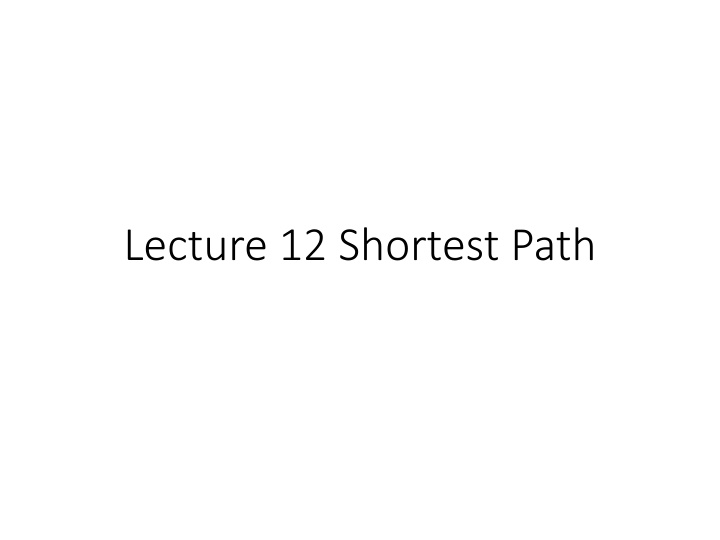
Shortest Path Algorithms in Graph Theory
Explore the concepts of Shortest Path Algorithms in Graph Theory, including BFS, properties of shortest paths, dynamic programming approach, and Dijkstra's algorithm. Understand how these algorithms efficiently find the shortest path between two vertices in a graph.
Uploaded on | 1 Views
Download Presentation

Please find below an Image/Link to download the presentation.
The content on the website is provided AS IS for your information and personal use only. It may not be sold, licensed, or shared on other websites without obtaining consent from the author. If you encounter any issues during the download, it is possible that the publisher has removed the file from their server.
You are allowed to download the files provided on this website for personal or commercial use, subject to the condition that they are used lawfully. All files are the property of their respective owners.
The content on the website is provided AS IS for your information and personal use only. It may not be sold, licensed, or shared on other websites without obtaining consent from the author.
E N D
Presentation Transcript
Recall BFS and Shortest Path Given a graph, vertices (u, v), find the path between (u, v) that minimizes the number of edges. Claim: The BFS tree rooted at u contains shortest paths to all vertices reachable from u. Proof by induction: Hypothesis For every L, BFS visits all vertices at distance at most L before visiting any vertex at distance more than L. Base case: L = 0 is trivial.
BFS proof Processed, distance L In the queue Assume Hypothesis is true for L. Consider the time when BFS finished processing all vertices with distance at most L. If a vertex has distance L, it is already processed If a vertex has distance > L+1, it cannot be in the queue If a vertex has distance = L+1, it must be in the queue
Shortest Path problem Given a graph G, edges have length w(u,v) > 0. (distance, travel time, cost, ) Length of a path is equal to the sum of edge lengths Goal: Given source s and destination t, find the paths with minimum length.
Designing the algorithm What properties do shortest paths have? Claim: Given a shortest paths from s to t, any sub-path is still a shortest path between its two end-points. Which basic design technique has this property?
Shortest Path by Dynamic Programming ? ? = min ?,? ?? ?,? + ?(?) Length of last step Shortest Path to a Predecessor Problem: Graph may have cycle. What ordering do I use?
Dijkstras algorithm Main idea: The correct ordering is an ascending order of distance from source. Intuition: To get to a point v, if the last step of shortest path is (u, v), then u should always be closer to s than v. If I have computed shortest paths for all vertices that are closer to s than v, then I m ready to compute shortest paths to v.
Dijkstras algorithm Dijkstra(s) initialize dis[u] to be all infinity, prev[u] to be NULL For neighbors of s, initialize dis[u] = w[s,u], prev[u] = s Mark s as visited FOR i = 2 to n Among all vertices that are not visited, find the one with smallest distance, call it u. Mark u as visited FOR all edges (u,v) IF dis[u]+w[u,v] < dis[v] THEN dis[v] = dis[u]+w[u,v] prev[v] = u.
Main step of proof Induction Hypothesis: At iteration i of Dijkstra s algorithm, the algorithm correctly computes the shortest path to i visited vertices, and for any vertex v that is not visited, dis[v] is the length of shortest path to v that only uses visited vertices. v u s visited
Main step of proof Choosing the next vertex v u s v u visited If v is the vertex with smallest dis[v], it cannot have a shorter path
Running time To analyze the running time of a graph algorithm, usually we want to analyze what is the average amount of time spent on each edge/vertex For Dijkstra We need to find the closest vertex n times. We need to update weight of edges m times. Na ve implementation: O(n) per vertex, O(1) per edge Use a binary heap: O(log n) per vertex and edge. Best: Use Fibonacci heap, O(log n) per vertex, O(1) per edge. Total runtime = O(m + nlog n)
